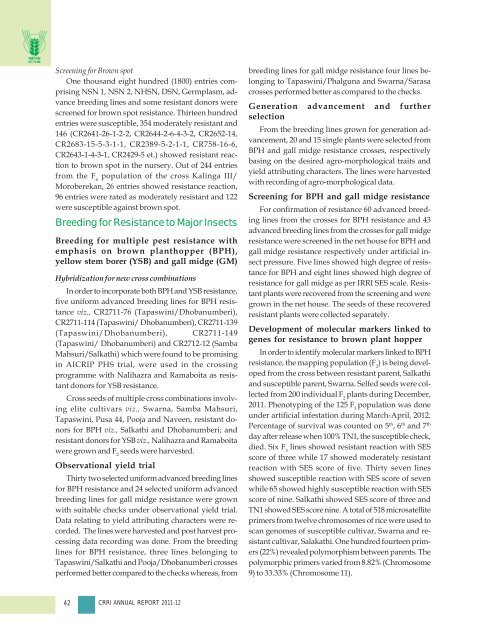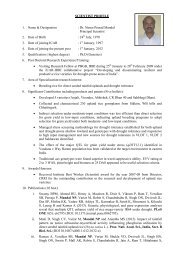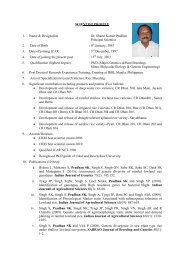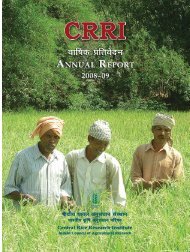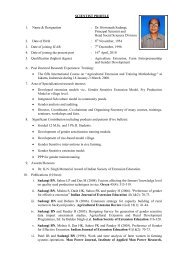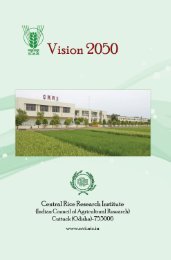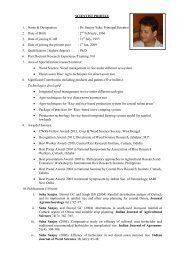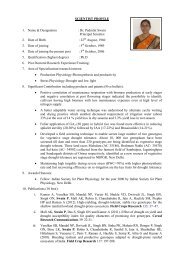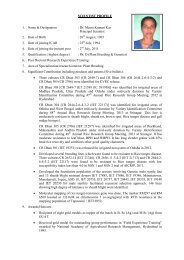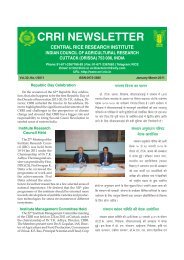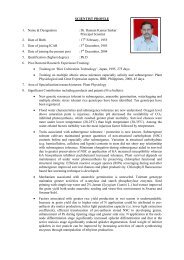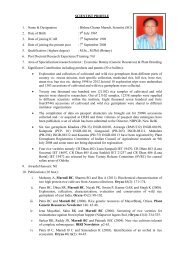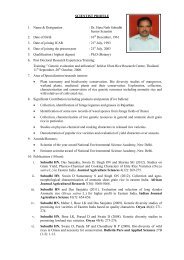Central Rice Research Institute Annual report...2011-12
Central Rice Research Institute Annual report...2011-12
Central Rice Research Institute Annual report...2011-12
You also want an ePaper? Increase the reach of your titles
YUMPU automatically turns print PDFs into web optimized ePapers that Google loves.
Screening for Brown spot<br />
One thousand eight hundred (1800) entries comprising<br />
NSN 1, NSN 2, NHSN, DSN, Germplasm, advance<br />
breeding lines and some resistant donors were<br />
screened for brown spot resistance. Thirteen hundred<br />
entries were susceptible, 354 moderately resistant and<br />
146 (CR2641-26-1-2-2, CR2644-2-6-4-3-2, CR2652-14,<br />
CR2683-15-5-3-1-1, CR2389-5-2-1-1, CR758-16-6,<br />
CR2643-1-4-3-1, CR2429-5 et.) showed resistant reaction<br />
to brown spot in the nursery. Out of 244 entries<br />
from the F 6<br />
population of the cross Kalinga III/<br />
Moroberekan, 26 entries showed resistance reaction,<br />
96 entries were rated as moderately resistant and <strong>12</strong>2<br />
were susceptible against brown spot.<br />
Breeding for Resistance to Major Insects<br />
Breeding for multiple pest resistance with<br />
emphasis on brown planthopper (BPH),<br />
yellow stem borer (YSB) and gall midge (GM)<br />
Hybridization for new cross combinations<br />
In order to incorporate both BPH and YSB resistance,<br />
five uniform advanced breeding lines for BPH resistance<br />
viz., CR2711-76 (Tapaswini/Dhobanumberi),<br />
CR2711-114 (Tapaswini/ Dhobanumberi), CR2711-139<br />
(Tapaswini/Dhobanumberi), CR2711-149<br />
(Tapaswini/ Dhobanumberi) and CR27<strong>12</strong>-<strong>12</strong> (Samba<br />
Mahsuri/Salkathi) which were found to be promising<br />
in AICRIP PHS trial, were used in the crossing<br />
programme with Nalihazra and Ramaboita as resistant<br />
donors for YSB resistance.<br />
Cross seeds of multiple cross combinations involving<br />
elite cultivars viz., Swarna, Samba Mahsuri,<br />
Tapaswini, Pusa 44, Pooja and Naveen, resistant donors<br />
for BPH viz., Salkathi and Dhobanumberi; and<br />
resistant donors for YSB viz., Nalihazra and Ramaboita<br />
were grown and F 2<br />
seeds were harvested.<br />
Observational yield trial<br />
Thirty two selected uniform advanced breeding lines<br />
for BPH resistance and 24 selected uniform advanced<br />
breeding lines for gall midge resistance were grown<br />
with suitable checks under observational yield trial.<br />
Data relating to yield attributing characters were recorded.<br />
The lines were harvested and post harvest processing<br />
data recording was done. From the breeding<br />
lines for BPH resistance, three lines belonging to<br />
Tapaswini/Salkathi and Pooja/Dhobanumberi crosses<br />
performed better compared to the checks whereas, from<br />
breeding lines for gall midge resistance four lines belonging<br />
to Tapaswini/Phalguna and Swarna/Sarasa<br />
crosses performed better as compared to the checks.<br />
Generation advancement and further<br />
selection<br />
From the breeding lines grown for generation advancement,<br />
20 and 15 single plants were selected from<br />
BPH and gall midge resistance crosses, respectively<br />
basing on the desired agro-morphological traits and<br />
yield attributing characters. The lines were harvested<br />
with recording of agro-morphological data.<br />
Screening for BPH and gall midge resistance<br />
For confirmation of resistance 60 advanced breeding<br />
lines from the crosses for BPH resistance and 43<br />
advanced breeding lines from the crosses for gall midge<br />
resistance were screened in the net house for BPH and<br />
gall midge resistance respectively under artificial insect<br />
pressure. Five lines showed high degree of resistance<br />
for BPH and eight lines showed high degree of<br />
resistance for gall midge as per IRRI SES scale. Resistant<br />
plants were recovered from the screening and were<br />
grown in the net house. The seeds of these recovered<br />
resistant plants were collected separately.<br />
Development of molecular markers linked to<br />
genes for resistance to brown plant hopper<br />
In order to identify molecular markers linked to BPH<br />
resistance, the mapping population (F 2<br />
) is being developed<br />
from the cross between resistant parent, Salkathi<br />
and susceptible parent, Swarna. Selfed seeds were collected<br />
from 200 individual F 2<br />
plants during December,<br />
2011. Phenotyping of the <strong>12</strong>5 F 3<br />
population was done<br />
under artificial infestation during March-April, 20<strong>12</strong>.<br />
Percentage of survival was counted on 5 th , 6 th and 7 th<br />
day after release when 100% TN1, the susceptible check,<br />
died. Six F 3<br />
lines showed resistant reaction with SES<br />
score of three while 17 showed moderately resistant<br />
reaction with SES score of five. Thirty seven lines<br />
showed susceptible reaction with SES score of seven<br />
while 65 showed highly susceptible reaction with SES<br />
score of nine. Salkathi showed SES score of three and<br />
TN1 showed SES score nine. A total of 518 microsatellite<br />
primers from twelve chromosomes of rice were used to<br />
scan genomes of susceptible cultivar, Swarna and resistant<br />
cultivar, Salakathi. One hundred fourteen primers<br />
(22%) revealed polymorphism between parents. The<br />
polymorphic primers varied from 8.82% (Chromosome<br />
9) to 33.33% (Chromosome 11).<br />
42 CRRI ANNUAL REPORT 2011-<strong>12</strong>


